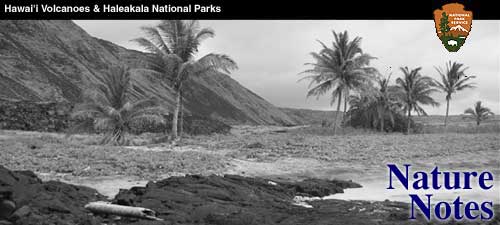

|
|
HAWAII NATURE NOTES
INTRODUCTION How the Plants Came The story of Hawaii's plants is fascinating. A few million years ago the Hawaiian Islands were barren volcanic domes rising from the Pacific. This building continues today; both Kilauea and Mauna Loa are among the world's most active volcanoes. As the rock turned into soil, plants and animals arrived from distant places to make their new homes. Several natural forces have played a part in bringing plants to Hawaii. Ferns and mosses reproduce by means of minute, dustlike spores. These spores can be carried for thousands of miles by winds. Other plants have seeds that migrate on the wind. Among these are orchids and the Railliardia.
The currents of the ocean probably carried in such plants as the pohuehue or beach morning-glory (Ipomoea pes-caprae), and the hala (Pandanus odoratissimus) from the leaves of which the attractive lauhala articles are made. These plants have buoyant seeds or fruits. Plants having sticky fruits such as the papala kepau and the Peperomia may have been brought on the plumage of birds blown to Hawaii by storms. Many plants have indigestible seeds which could have been carried within the digestive tracts of birds. The akala or Hawaiian raspberry has seeds of this type. It is estimated that more than 90 percent of the native Hawaiian plants are found only in the Islands, having been changed by local conditions from the ancestral forms which first reached Hawaii. Such plants are termed "endemic," while those growing as natives which have not been changed as yet from their relatives growing in other places are called "indigenous." Plants brought here by man are classed as "introduced" or "exotic." Since the coming of the explorers in the late 18th century, many changes have taken place in the Hawaiian plant picture. Exotics have been introduced as garden ornamentals, in feed for stock, and for human consumption. Some native plants have completely disappeared from the original flora because of competition with hardier exotics. Introduced animals such as domestic goats, pigs, sheep and cattle have taken a toll of native plants. The clearing of thousands of acres of land for agriculture has been very important in the extermination or reduction of much native flora and many native birds. One of the most interesting and beautiful places in the park to see native plants is Kipuka Puaulu (Bird Park). Climate Hawaii is one of the few places in the world where you can walk a few hundred yards from an area of heavy rainfall to one of extreme dryness, as you can in the Kilauea section of Hawaii National Park. Near Park Headquarters annual rainfall averages about 100 inches. Across Kilauea crater the rainfall is much less. The Kau Desert, a normally arid section, begins at the edge of Kilauea and extends for some miles. The north-east side of these islands tend to get the heaviest rainfall, since predominant trade winds force moisture-laden clouds up over the mountain masses from this direction. Plants are dependent upon rainfall for survival. The dense fern jungles of the Kilauea section are an example of what might be termed a "rain jungle." The Kau desert is the opposite extreme. In spite of the lack of moisture in the desert areas, a large number of plant species are able to survive and thrive. The amaumau fern is one of the most common plants to be found both in the desert areas and on recent lava flows. Hawaii National Park Hawaii National Park will always remain an area where native species are given full protection. It was set aside by Congress in 1916 to preserve, ". . . in such manner and by such means as will leave . . . unimpaired for future generations . . ." not only one of the world's most spectacular volcanic areas, but the plant and birdlife of the two sections, the Kilauea on Hawaii and the Haleakala on Maui. This Bulletin Some of the plants of Hawaii will be familiar, while others—particularly those found only in the Hawaiian Islands—will not. It is hoped that this bulletin will enable you to become familiar with some of the more common plants and to appreciate the fact that many of the plant species being protected here may be seen in an unspoiled condition only in this park. Trees and ferns are not included in this booklet as they are the subject of other publications. All photos are by the authors unless otherwise credited.
|
| <<< Previous | > Cover < | Next >>> |
nature_notes/havo/vol4-1a.htm
24-Mar-2006